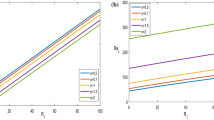Abstract
Similarity profiles of pressure and saturation are analysed which result from one-dimensional planar withdrawal of fluid from a porous region initially containing a two phase mixture of steam and water. Approximate expressions are derived for the evolution of pressure and saturation profiles, and boundary-layer changes in saturation are identified. The existence of a similarity variable implies that the saturation conditions for the reservoir tend with time either to having both phases flowing; or to a single phase vapour. In particular, the nonlinear nature of the governing equations implies that infinitesimal changes in pressure can produce finite changes in saturation. The two mechanisms responsible for saturation changing with time involve local changes in energy storage in rock and fluid; together with spatial variations in flowing enthalpy. The latter mechanism occurred relatively slowly in the examples treated, and was responsible for boundary-layer formation when one phase was initially immobile. Dimensional analysis reveals that when a boundary layer develops, the underlying equations involve essentially only one dimensionless parameter which is typically small, being associated with the ratio of the energy density of the mobile phase relative to the total energy density.
Similar content being viewed by others
References
Abramowitz, M. and Stegun, I. A., 1972, Handbook of Mathematical Functions with Formulas, Graphs and Mathematical Tables, Dover, London.
Earlougher, R. C., 1977, Advances in Well Test Analysis, Monograph 5, Society of Petroleum Engineers, American Institute of Mining, Metallurgical and Petroleum Engineers, Dallas, Texas.
Garg, S. K., 1980, Pressure transient analysis of two-phase (liquid water/steam) geothermal reservoirs, Soc. Pet. Eng. J. 20, 206–214.
Garg, S. K. and Pritchett, J. W., 1988, Pressure interference data analysis for two-phase (water/steam) geothermal reservoirs, Water Resour. Res. 26, 843–852.
Grant, M. A., 1978, Two-phase linear geothermal pressure transients: A comparison with single-phase transients, NZ J. Sci. 21, 355–364.
Grant, M. A. and Sorey, M. L., 1979, The compressibility and hydraulic diffusivity of a water-steam flow, Water Resour. Res. 15, 684–686.
Moench, A. F. and Atkinson, P. G., 1978, Transient pressure analysis in geothermal steam reservoirs with an immobile vaporizing liquid phase, Geothermics 7, 253–264.
O'Sullivan, M. J., 1981, A similarity method for geothermal well test analysis, Water Resour. Res. 17, 390–398.
Pruess, K., 1983, Development of the general purpose simulator MULKOM Annual Report 1982, Earth Sciences Division Report LBL-15500, Lawrence Berkeley Laboratory.
Pruess, K. and Schroeder, R. C., 1979, Geothermal reservoir simulations with Shaft79, paper presented at the Fifth Annual Workshop on Geothermal Reservoir Engineering, Stanford Univ., Stanford, Calif., Dec. 12–14.
Reda, D. C. and Eaton, R. R., 1980, Influence of steam/water relative permeability models on predicted geothermal reservoir performance: a sensitivity study, paper to Sixth Annual Workshop on Geothermal Reservoir Engineering, Stanford University, December 16–18.
Sorey, M. L., Grant, M. A., and Bradford, E., 1980, Nonlinear effects on two-phase flow to wells in geothermal reservoirs, Water Resour. Res. 16, 767–777.
Touma, J. and Vauclin, M., 1986., Experimental and numerical analysis of two-phase infiltration in a partially saturated soil, Transport in Porous Media 1, 27–55.
Udell, K. S. and Fitch, J. S., 1985, Heat and mass transfer in capillary porous media considering evaporation, condensation, and non-condensible gas effects, paper presented at 23rd ASME/AIChE National Heat Transfer Conference, Denver, CO, August.
Zyvoloski, G. A., O'Sullivan, M. J., and Krol, D. E., 1979, Finite difference techniques for modelling geothermal reservoirs, Int. J. Numer. Anal. Meth. Geomech. 3, 355–366.
Author information
Authors and Affiliations
Rights and permissions
About this article
Cite this article
Burnell, J.G., McNabb, A., Weir, G.J. et al. Two-phase boundary layer formation in a semi-infinite porous slab. Transp Porous Med 4, 395–420 (1989). https://doi.org/10.1007/BF00165781
Received:
Issue Date:
DOI: https://doi.org/10.1007/BF00165781




